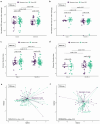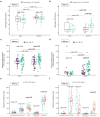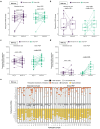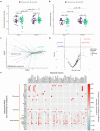This is a preprint.
Doxycycline post-exposure prophylaxis for sexually transmitted infections impacts the gut antimicrobial resistome
- PMID: 38699315
- PMCID: PMC11065088
- DOI: 10.21203/rs.3.rs-4243341/v1
Doxycycline post-exposure prophylaxis for sexually transmitted infections impacts the gut antimicrobial resistome
Update in
-
Impact of doxycycline post-exposure prophylaxis for sexually transmitted infections on the gut microbiome and antimicrobial resistome.Nat Med. 2025 Jan;31(1):207-217. doi: 10.1038/s41591-024-03274-2. Epub 2024 Oct 3. Nat Med. 2025. PMID: 39363100 Free PMC article. Clinical Trial.
Abstract
Doxycycline post-exposure prophylaxis (doxy-PEP) reduces bacterial sexually transmitted infections (STIs) among men who have sex with men and transgender women. While poised for widespread clinical implementation, the impact of doxy-PEP on antimicrobial resistance remains a primary concern as its effects on the gut microbiome and resistome, or the antimicrobial resistance genes (ARGs) present in the gut microbiome, are unknown. To investigate these effects, we studied participants from a randomized clinical trial who either received doxy-PEP as a one-time doxycycline 200 mg taken after condomless sex (DP arm, n = 100) or standard of care treatment (SOC arm, n = 50). From self-collected rectal swabs at enrollment (day-0) and after 6 months (month-6), we performed metagenomic DNA sequencing (DNA-seq) or metatranscriptomic RNA sequencing (RNA-seq). DNA-seq data was analyzable from 127 samples derived from 89 participants, and RNA-seq data from 86 samples derived from 70 participants. We compared the bacterial microbiome and resistome between the two study arms and over time. Tetracycline ARGs were detected in all day-0 DNA-seq samples and 85% of day-0 RNA-seq samples. The proportional mass of tetracycline ARGs in the resistome increased between day-0 and month-6 in DP participants from 46-51% in the metagenome (p = 0.02) and 4-15% in the metatranscriptome (p < 0.01), but no changes in other ARG classes were observed. Exposure to a higher number of doxycycline doses correlated with proportional enrichment of tetracycline ARGs in the metagenome (Spearman's ρ = 0.23, p < 0.01) and metatranscriptome (Spearman's ρ = 0.55, p < 0.01). Bacterial microbiome alpha diversity, beta diversity, and total bacterial mass did not differ between day-0 and month-6 samples from DP participants when assessed by either DNA-seq or RNA-seq. In an abundance-based correlation analysis, we observed an increase over time in the strength of the correlation between tetracycline ARGs and specific bacterial taxa, including some common human pathogens. In sum, doxy-PEP use over a 6-month period was associated with an increase in the proportion of tetracycline ARGs comprising the gut resistome, and an increase in the expression of tetracycline ARGs. Notably, doxy-PEP did not significantly alter alpha diversity or taxonomic composition of the gut microbiome, and did not demonstrate significant increases in non-tetracycline ARG classes. Further studies and population level surveillance are needed to understand the implications of these findings as doxy-PEP is implemented as a public health strategy.
Keywords: antibiotic resistance; antimicrobial resistance; doxy-PEP; doxycycline; men who have sex with men; resistome; sexually transmitted infection.
Conflict of interest statement
Disclosures Mayne Pharmaceuticals donated doxycycline hyclate to the study and Cepheid and Hologic provided reagents and STI diagnostic assays. Several authors have served as a scientific adviser to Merck (CC, DD), Gilead Sciences (CC), GSK (CC) and Vir (AL). All other authors have no conflict of interests to declare.
Figures





References
-
- Centers for Disease Control and Prevention. Guidelines for the Use of Doxycycline Post-Exposure Prophylaxis for Bacterial STI Prevention, <https://www.cdc.gov/std/treatment/guidelines-for-doxycycline.htm#print> (2023).
-
- World Health Organization. WHO announces the development of the Consolidated Guidelines on STI prevention and care (2022–2023), <https://www.who.int/news/item/18-05-2023-who-announces-the-development-o...> (2023).
Publication types
Grants and funding
LinkOut - more resources
Full Text Sources
Miscellaneous

